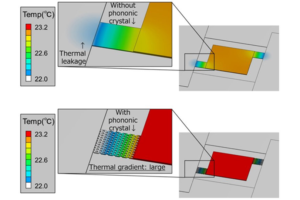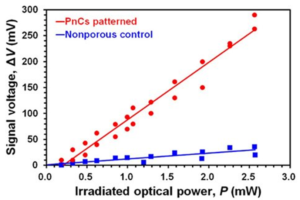Panasonic develops the world’s first sensitivity improvement technology for far infrared sensors with a phononic crystal structure.
In the AI and IoT era, electronic devices tend to be packaged smaller and in higher density than ever. Increase in hot spots and unexpected heat flow in these devices have been a major concern as they can easily disturb the device performances. Therefore, development of an innovative thermal management technology is highly demanded for next generation microelectronic devices. Recent studies have revealed that the classical limitation of thermal insulation performance of solids can be broken in an artificial structure with nanometer-scale periodic elastic continuum. Such artificial periodic structures are called phononic crystals, which allow for manipulating the propagation of phonons that dominate the thermal properties of semiconductors. However, extremely fine nanostructure patterns in the order of sub-50 nm are necessary to maximise the thermal insulation performance of phononic crystals. This feature made it difficult to employ the standard microfabrication tools used in conventional semiconductor foundries, which had hindered the practical leveraging of the unique feature of phononic crystals to electronic devices. Panasonic developed a technology to fabricate phononic crystal structures in which the diameter and the period of pores are precisely controlled in the order of several tens of nanometers.
The technology developed here is applicable to mass production on Si wafers. This newly developed technology enables the company to enhance the thermal insulation performance of Si thin films by a factor of ten. Panasonic has adopted this technology to Si supporting legs of infrared sensors to significantly improve the thermal insulation performance and to increase the temperature rise of the infrared-receiving section upon infrared absorption. This eventually led to improvement of the infrared detection sensitivity by a factor of ten. With these sensors, infrared detection sensitivity was improved nearly by a factor of 10 in the sensors with phononic crystals. Panasonic presented this world’s first research result on phononic far infrared sensors as an invited talk at SPIE Defense + Commercial Sensing 2021, which is one of the five major conferences of the SPIE (the international society for optics and photonics) in the fields of optics, photonics, and image engineering. Utilising this technology, Panasonic will provide new thermography solutions with higher temperature resolutions and innovative thermal management solutions in microelectronic devices through exploring the possibilities of collaboration with partners.
Main features
- Panasonic has developed a process technology applicable to mass production of phononic crystals with a pitch size of less than 100 nm.
- Compared to the thermal conductivity of bulk Si thin film (31.2 W/mK), highly reduced thermal conductivity was achieved in Si thin films with phononic crystals (3.6 W/ mK).
- Infrared detection sensitivity was increased by a factor of ten compared to the conventional infrared sensors without phononic crystal structures.
Technological Information Mass of phononic crystal structures
Phononic crystal structures with sub-100 nm periodicity are usually fabricated by an electron beam lithography*5 nanopatterning process. However, in electron beam lithography, the patterns are fabricated by scanning the focused electron beam in twodimensions. The scanning process in electron beam lithography restricts the throughput for mass production. Panasonic has adopted a block copolymer*6 self-assembly process*7 for phononic crystal fabrication, which is highly applicable to mass production. In a collaborative research with the University of Chicago, Panasonic has succeeded in reducing the cylinder structure of phononic crystals with a diameter of 26 nm and a periodicity of 38 nm, thereby breaking the classical limitation of the thermal insulation performance of bulk Si.
Thermal conductivity reduction by phononic crystal structure
Panasonic has successfully transferred the self-assembly pattern of block copolymers on the supporting legs of far infrared sensors fabricated on Si (100 nm) / SiO2 (2000 nm) / Si wafers. The thermal conductivity of Si thin films was reduced from 31.2 W/mK to 3.6 W/ mK by the introduction of the phononic crystal structure. The thermal insulation performance achieved in the company’s phononic crystal is much greater than that achieved in classical porous Si. Figure 2 shows the simulated temperature distribution of the infrared sensor with and without phononic crystals upon absorption of infrared radiation. Panasonic sees a huge increase in temperature rise of the infrared receiving section of the phononic infrared sensor due to enhancement in its thermal insulation performance. The company demonstrates that its phononic far infrared sensor can be much sensitive in infrared detection than in the standard infrared sensors. Note: Phononic crystal structure effectively hinders the propagation of phonons in a completely new fashion breaking the classical limitation of thermal insulation performance in porous media.
Improved sensitivity of far infrared sensors using a phononic crystal structure
Thermoelectric voltage of infrared sensors with and without phononic crystals were measurement upon heating the infrared receiver by an infrared laser (Fig. 3). Panasonic found that the thermoelectric voltage of phononic far infrared sensors was approximately ten times higher than that of the nonporous sensor without a phononic crystal structure. This result demonstrates the potential of phononic crystals to enhance the infrared detection sensitivity. Note: The infrared-receiving section shown in Fig. 1 is heated by an infrared laser, and the thermoelectric voltage generated between the two electrodes is measured. Footnotes
- Phononic crystal modifies the original phonon dispersion of solids allowing for creating new thermal properties of solids.
- Classical limitation of thermal insulation performance that can be obtained in porous media with macroscopic sized pores.
- Scanning electron microscope: Microscopic images can be achieved by scanning the focused electron beam on semiconductor surfaces. The electron beam creates secondary electrons from the sample surface, which allow for obtaining information about the surface topography of the sample.
- A lithography technology to fabricate phononic crystals by scanning a focused electron beam in two-dimensions.
- A polymer which is composed by two different polymers with different surface free energy, such as hydrophilic and hydrophobic materials.
- A lithography technology to form a sub-50 nm scale fine periodic structure based on self-assembly of block copolymers.

For more details, visit – https://news.panasonic.com/
Cookie Consent
We use cookies to personalize your experience. By continuing to visit this website you agree to our Terms & Conditions, Privacy Policy and Cookie Policy.















